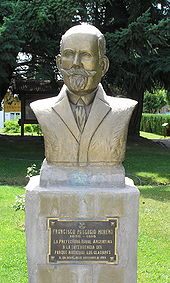Perito Moreno

Perito Moreno , actually Francisco Pascasio Moreno (born May 31, 1852 in Buenos Aires , † November 22, 1919 in Buenos Aires), was an Argentine geographer , anthropologist and explorer. In numerous expeditions he explored Patagonia and its flora and fauna in particular .
In 1872 he was one of the founders of the Sociedad Científica Argentina .
In 1882, in La Plata, the capital of the province of Buenos Aires, he became the first director of the La Plata Museum in 1885 .
“Perito” means “expert” in Spanish, an official title he received in 1902 with the title Perito de la Comisión de Limites during the border survey of Chile and Argentina. The definition of the border between Argentina and Chile in the Andes was made through British mediation. Moreno was there with various companions, such as Emilio Frey , Clemente Onelli and Santiago Roth and the British referee Sir Thomas Holdich. Thanks to the knowledge of the area and the area he gained on his expeditions, Moreno was able to significantly influence the drawing of boundaries in the interests of Argentina. For example, he was able to prove that various glacial lakes, in particular Lago Lácar, belong to the catchment area of the Atlantic (and thus according to the border treaty of 1881 with Argentina) , despite runoff into the Pacific , because their natural runoff is only blocked by moraines .
Moreno was also politically active. In 1910 he became a national member of parliament and in 1912 vice president of the national education council. Moreno founded a school for children from poor families in the southern part of Buenos Aires, which was later expanded with the help of the Swiss immigrant Felix Bernasconi and the Argentine state to form the Bernasconi Institute, the largest school in Buenos Aires after 1929.
Moreno was involved as a co-founder of the scout movement in Argentina and in 1912 became president of its national organization.
He made his last trip to Patagonia in 1912 as a companion of the US-American ex-President Theodore Roosevelt .
Named after him (all in Patagonia):
- a small town, see Perito Moreno (town)
- a national park, see Perito Moreno (national park)
- a glacier in Los Glaciares National Park , a major tourist attraction in Argentina, see Perito Moreno Glacier
He is also the namesake for Moreno Rock and Point Moreno in the Antarctic .
Web links
| personal data | |
|---|---|
| SURNAME | Moreno, Perito |
| ALTERNATIVE NAMES | Pascasio Moreno, Francisco (real name) |
| BRIEF DESCRIPTION | Argentine geographer and anthropologist |
| DATE OF BIRTH | May 31, 1852 |
| PLACE OF BIRTH | Buenos Aires |
| DATE OF DEATH | November 22, 1919 |
| Place of death | Buenos Aires |
